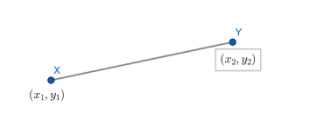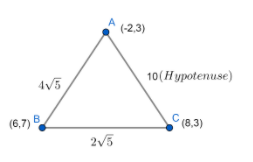
Show that the points $\left( -2,3 \right),\left( 8,3 \right)$ and $\left( 6,7 \right)$
are the vertices of a right triangle.
Answer
608.4k+ views
Hint: Use the basic rule of Pythagoras theorem to prove it.
Let us roughly draw a triangle with the given vertices:

Now, let us calculate distances between the points of triangle:
As we have the distance formula for two vertices in $2-D$ as
If two points $X\left( {{x}_{1}},{{y}_{1}} \right)\And Y\left( {{x}_{2}}{{y}_{2}} \right)$ are given
then

$xy=\sqrt{{{\left( {{x}_{1}}-{{x}_{2}} \right)}^{2}}+{{\left( {{y}_{1}}-{{y}_{2}} \right)}^{2}}}$
By using above formula now let’s calculate $AB,BC,AC:$
$AB=\sqrt{{{\left( -2-6 \right)}^{2}}+{{\left( 3-7 \right)}^{2}}}\text{ }\left( \text{as }A=\left( -
2,3 \right)B=\left( 6,7 \right) \right)$
\[\begin{align}
& AB=\sqrt{64+16} \\
& AB=\sqrt{80}=\sqrt{4\times 4\times 5}.................\left( 1 \right) \\
& AB=4\sqrt{5} \\
\end{align}\]
Now, Let’s calculate $BC\text{ }\left( \text{as }B=\left( 6,7 \right)C=\left( 8,3 \right) \right)$
\[\begin{align}
& BC=\sqrt{{{\left( 6-8 \right)}^{2}}+{{\left( 7-3 \right)}^{2}}} \\
& BC=\sqrt{4+16} \\
& BC=\sqrt{20}=\sqrt{2\times 2\times 5}................\left( 2 \right) \\
& BC=2\sqrt{5} \\
\end{align}\]
Now,
$\begin{align}
& AC=\sqrt{{{\left( -2-8 \right)}^{2}}+{{\left( 3-3 \right)}^{2}}} \\
& AC=\sqrt{100}=10...........\left( 3 \right) \\
\end{align}$
Hence we can observe that $AC$ has the highest length in $AB,BC\And AC$ .
Therefore if $ABC$ will represent a right angle triangle then it will show or follow Pythagoras
property and $AC$ will be the Hypotenuse length.
As Pythagoras property can be expressed as following:

$x{{y}^{2}}+y{{z}^{2}}=x{{z}^{2}}$
Where $xz$ is Hypotenuse and biggest in length among the three sides.
Hence, if $ABC$ will represent right angle triangle then:

It will follow
\[\begin{align}
& A{{B}^{2}}+B{{C}^{2}}=A{{C}^{2}} \\
& {{\left( 4\sqrt{5} \right)}^{2}}+{{\left( 2\sqrt{5} \right)}^{2}}={{\left( 10
\right)}^{2}}=100 \\
\end{align}\]
Let LHS (Left Hand Side):
$\begin{align}
& {{\left( 4\sqrt{5} \right)}^{2}}+{{\left( 2\sqrt{5} \right)}^{2}}=80+20 \\
& =100=RHS \\
\end{align}$
Hence, It is proved that $ABC$ is a right angled triangle at $B$ with $AC$ as Hypotenuse.
Note: In straight line we learn concept of calculating slope of a line and property of
perpendicular lines as well which is “If two lines are perpendicular then; $Slope\left( Line1
\right)\times Slope\left(Line2 \right)=-1.........\left( 1 \right)$
As right angle triangle will have 3 lines and all have slope, and if two of them will follow
equation $\left( 1 \right)$ then the triangle will be a right angled triangle. This proving is
more advanced than the provided solution.
We have formula of slope as
$m=\dfrac{{{y}_{2}}-{{y}_{1}}}{{{x}_{2}}-{{x}_{1}}}$ with a line of two points given as $\left(
{{x}_{1}},{{y}_{1}} \right)\And \left( {{x}_{2}}{{y}_{2}} \right)$ .
Now in given triangle
\[\begin{align}
& {{m}_{AB}}=\dfrac{{{y}_{2}}-{{y}_{1}}}{{{x}_{2}}-{{x}_{1}}}=\dfrac{3-7}{-2-6}=\dfrac{-4}{-
8}=\dfrac{1}{2} \\
& {{m}_{BC}}=\dfrac{7-3}{6-8}=\dfrac{-4}{2}=-2 \\
& \text{As }{{\text{m}}_{AB}}\times {{m}_{BC}}=-1 \\
\end{align}\]
Hence, $ABC$ have $B$ angle as $90{}^\circ $.
Therefore $ABC$is a right angle triangle.
We can calculate angle between the lines by using formula
$\tan \theta =\left| \dfrac{{{m}_{1}}-{{m}_{2}}}{1+{{m}_{1}}{{m}_{2}}} \right|$ where
${{m}_{1}}\And {{m}_{2}}$ are slopes of two lines between which we need to find angle and
slopes can be calculated by formula $m=\dfrac{{{y}_{2}}-{{y}_{1}}}{{{x}_{2}}-{{x}_{1}}}$ .
Hence; this can be the angel approach as well but it may be lengthy than the above two discussed problems.
Let us roughly draw a triangle with the given vertices:

Now, let us calculate distances between the points of triangle:
As we have the distance formula for two vertices in $2-D$ as
If two points $X\left( {{x}_{1}},{{y}_{1}} \right)\And Y\left( {{x}_{2}}{{y}_{2}} \right)$ are given
then

$xy=\sqrt{{{\left( {{x}_{1}}-{{x}_{2}} \right)}^{2}}+{{\left( {{y}_{1}}-{{y}_{2}} \right)}^{2}}}$
By using above formula now let’s calculate $AB,BC,AC:$
$AB=\sqrt{{{\left( -2-6 \right)}^{2}}+{{\left( 3-7 \right)}^{2}}}\text{ }\left( \text{as }A=\left( -
2,3 \right)B=\left( 6,7 \right) \right)$
\[\begin{align}
& AB=\sqrt{64+16} \\
& AB=\sqrt{80}=\sqrt{4\times 4\times 5}.................\left( 1 \right) \\
& AB=4\sqrt{5} \\
\end{align}\]
Now, Let’s calculate $BC\text{ }\left( \text{as }B=\left( 6,7 \right)C=\left( 8,3 \right) \right)$
\[\begin{align}
& BC=\sqrt{{{\left( 6-8 \right)}^{2}}+{{\left( 7-3 \right)}^{2}}} \\
& BC=\sqrt{4+16} \\
& BC=\sqrt{20}=\sqrt{2\times 2\times 5}................\left( 2 \right) \\
& BC=2\sqrt{5} \\
\end{align}\]
Now,
$\begin{align}
& AC=\sqrt{{{\left( -2-8 \right)}^{2}}+{{\left( 3-3 \right)}^{2}}} \\
& AC=\sqrt{100}=10...........\left( 3 \right) \\
\end{align}$
Hence we can observe that $AC$ has the highest length in $AB,BC\And AC$ .
Therefore if $ABC$ will represent a right angle triangle then it will show or follow Pythagoras
property and $AC$ will be the Hypotenuse length.
As Pythagoras property can be expressed as following:

$x{{y}^{2}}+y{{z}^{2}}=x{{z}^{2}}$
Where $xz$ is Hypotenuse and biggest in length among the three sides.
Hence, if $ABC$ will represent right angle triangle then:

It will follow
\[\begin{align}
& A{{B}^{2}}+B{{C}^{2}}=A{{C}^{2}} \\
& {{\left( 4\sqrt{5} \right)}^{2}}+{{\left( 2\sqrt{5} \right)}^{2}}={{\left( 10
\right)}^{2}}=100 \\
\end{align}\]
Let LHS (Left Hand Side):
$\begin{align}
& {{\left( 4\sqrt{5} \right)}^{2}}+{{\left( 2\sqrt{5} \right)}^{2}}=80+20 \\
& =100=RHS \\
\end{align}$
Hence, It is proved that $ABC$ is a right angled triangle at $B$ with $AC$ as Hypotenuse.
Note: In straight line we learn concept of calculating slope of a line and property of
perpendicular lines as well which is “If two lines are perpendicular then; $Slope\left( Line1
\right)\times Slope\left(Line2 \right)=-1.........\left( 1 \right)$
As right angle triangle will have 3 lines and all have slope, and if two of them will follow
equation $\left( 1 \right)$ then the triangle will be a right angled triangle. This proving is
more advanced than the provided solution.
We have formula of slope as
$m=\dfrac{{{y}_{2}}-{{y}_{1}}}{{{x}_{2}}-{{x}_{1}}}$ with a line of two points given as $\left(
{{x}_{1}},{{y}_{1}} \right)\And \left( {{x}_{2}}{{y}_{2}} \right)$ .
Now in given triangle
\[\begin{align}
& {{m}_{AB}}=\dfrac{{{y}_{2}}-{{y}_{1}}}{{{x}_{2}}-{{x}_{1}}}=\dfrac{3-7}{-2-6}=\dfrac{-4}{-
8}=\dfrac{1}{2} \\
& {{m}_{BC}}=\dfrac{7-3}{6-8}=\dfrac{-4}{2}=-2 \\
& \text{As }{{\text{m}}_{AB}}\times {{m}_{BC}}=-1 \\
\end{align}\]
Hence, $ABC$ have $B$ angle as $90{}^\circ $.
Therefore $ABC$is a right angle triangle.
We can calculate angle between the lines by using formula
$\tan \theta =\left| \dfrac{{{m}_{1}}-{{m}_{2}}}{1+{{m}_{1}}{{m}_{2}}} \right|$ where
${{m}_{1}}\And {{m}_{2}}$ are slopes of two lines between which we need to find angle and
slopes can be calculated by formula $m=\dfrac{{{y}_{2}}-{{y}_{1}}}{{{x}_{2}}-{{x}_{1}}}$ .
Hence; this can be the angel approach as well but it may be lengthy than the above two discussed problems.
Recently Updated Pages
Master Class 9 Social Science: Engaging Questions & Answers for Success

Master Class 9 Science: Engaging Questions & Answers for Success

Master Class 9 English: Engaging Questions & Answers for Success

Master Class 9 Maths: Engaging Questions & Answers for Success

Master Class 9 General Knowledge: Engaging Questions & Answers for Success

Class 9 Question and Answer - Your Ultimate Solutions Guide

Trending doubts
Which places in India experience sunrise first and class 9 social science CBSE

Fill the blanks with the suitable prepositions 1 The class 9 english CBSE

Write the 6 fundamental rights of India and explain in detail

Difference Between Plant Cell and Animal Cell

What is pollution? How many types of pollution? Define it

What is the Full Form of ISI and RAW




